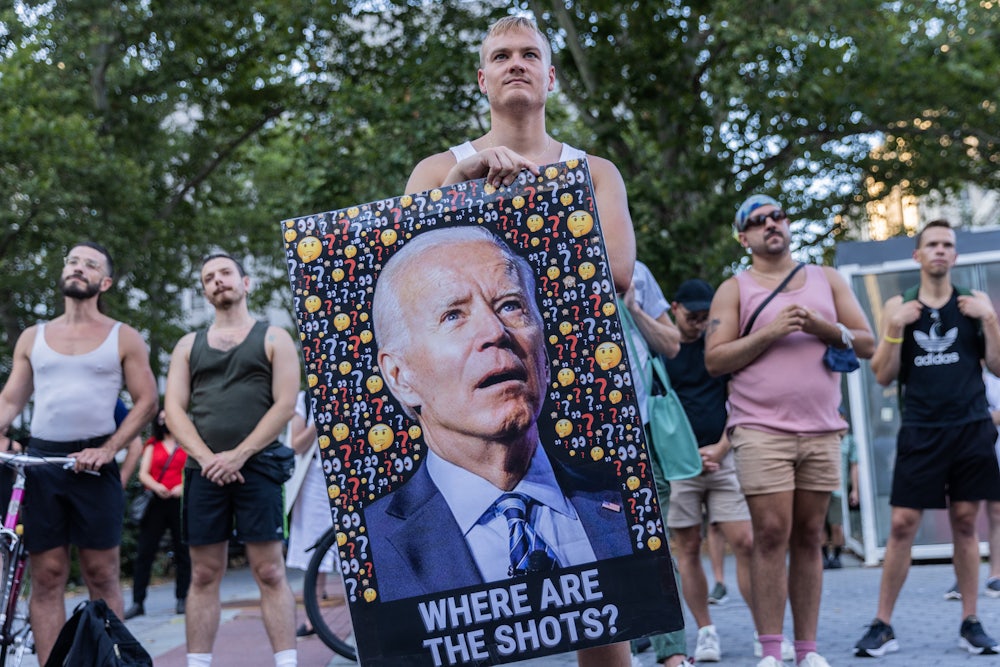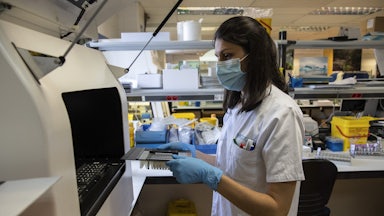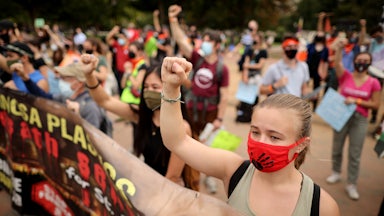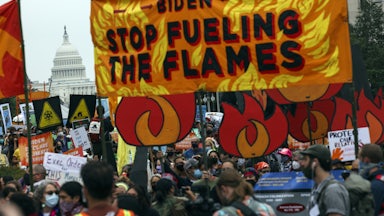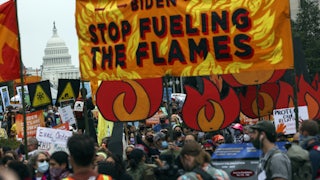When Sebastian Köhn woke up on the Saturday before Independence Day, he knew something was wrong. He’d slept for 12 hours straight, and he had a high fever, chills, muscle pain, and extremely swollen lymph nodes. He immediately suspected monkeypox.
Ten days earlier, Köhn had tried to get the monkeypox vaccine before attending Pride festivities in New York City, but he couldn’t find any appointments. Köhn, who works to fund projects and organizations focused on sexual health and access to medicines at a philanthropic foundation, was concerned. But the outbreak in New York seemed pretty small so far—he didn’t realize that the city was only running 10 monkeypox tests a day—and he was used to weighing risks as a 39-year-old sexually active gay man living through multiple concurrent epidemics. A few days after attending Pride, though, his symptoms began. He soon developed a rash and hives over most of his body, as well as unspeakably painful lesions that made the simplest of tasks, like using the bathroom, an hours-long ordeal.
In the past two months, monkeypox has exploded in countries that have never before seen major transmission. Previously, when cases in the United States were linked to a traveler or an animal exposure, the outbreaks were quashed quickly and effectively, thanks to the disease’s distinctive symptoms and the quick implementation of contact tracing, isolation, and vaccination programs. In this outbreak, however, global case counts have already reached 16,000 cases and five deaths. On Friday, the U.S. reported the first two cases of monkeypox in children.
Unlike when Covid-19 took the world by surprise, highly effective vaccines and antivirals already exist to treat poxviruses. So why has Köhn suffered for the past three weeks? Not only could he not get vaccinated, but it took him a week to get a topical treatment just to ease his excruciating pain. He struggled for days to access antivirals while feverish; he knows others with symptoms who have given up on getting the treatment or even getting their test results back. A contact tracer called Köhn 12 days after his first symptoms began to let him know he may have been exposed in June—but after asking detailed questions about his symptoms, the contact tracer hung up without asking about the people Köhn might have had contact with while contagious.
On Saturday, Dr. Tedros Adhanom Ghebreyesus, director-general of the World Health Organization, declared that monkeypox is a public health emergency of international concern, despite a special WHO committee being unable to reach consensus. That kind of indecisiveness represents much of the monkeypox response so far. With more than 2,800 cases and counting, the U.S. is already failing at its monkeypox response, and without urgent efforts, the virus could establish itself permanently.
“I think we’re at a really critical juncture—if, unfortunately, we haven’t passed it already,” Köhn said, when it comes to containing this disease. “I think we’re very, very, very close to this just becoming something that we’re going to have to deal with forever.”
“It’s clear that we’re going in the wrong direction,” said Gregg Gonsalves, an epidemiologist at Yale School of Public Health. “We could have treated this like an emergency, both globally and domestically, in May.… It should be all hands on deck.” In order to curtail the outbreak, officials need to focus urgently on diagnosing and preventing cases in the communities and close contacts of those at most risk.
Data from the U.K. indicates that monkeypox is primarily spreading among men who have sex with men, which means they need to be alerted to the risks and have access to prevention and treatment—to keep both themselves and others safe from a virus that could soon spiral even further out of control. But because of the continued difficulties in getting tested, health experts have said for weeks that it was possible the virus is already spreading elsewhere. Troublingly, a case was recently identified in a child from the Netherlands who had no known exposure to monkeypox. With the U.S. now reporting two cases of monkeypox in children as a result of household transmission, experts say cases like these will likely multiply in other communities as long as the outbreak is allowed to grow.
“It easily could jump into populations where other close physical contact is common,” Gonsalves said. That could include gyms, homeless shelters, and schools and daycares. Monkeypox is spread through close contact, including but not limited to sex, and children and pregnant people are particularly vulnerable to its ravages.
In June, the WHO declined to declare a public health emergency of international concern, although experts argued that the crisis met the definition. “There was a strange sort of ‘we can deal with this’ attitude,” Gonsalves said. “There should have been a war room at the CDC.… We need an emergency response that’s across agencies, across levels of government—federal, local, and state. Yet it’s all been a very seat-of-your-pants approach to this, with some resignation and ambivalence about whether it’s important enough to pull the fire alarm. The fire alarm should’ve been pulled weeks ago.”
One area where America’s lack of preparation has been visible from the start is in vaccines. The Jynneos vaccines can prevent both monkeypox and smallpox. But of the 30 million doses in the U.S. stockpile, 28 million have expired. As of July 19, only 191,372 doses from that stockpile have been delivered to states and providers, with another 2.5 million doses ordered for late 2022 and early 2023. “The house is on fire, and you’re talking about water delivery in December?” Gonsalves said.
The U.S. has another 800,000 doses waiting for final inspection in a Danish warehouse; it’s not clear why they weren’t inspected at the start of the outbreak, or if the stockpile in Denmark figured into U.S. planning up to this point. “You don’t even know where your own vaccine stockpile is,” Gonsalves marveled. “There’s just basic mismanagement going on now that is either built into the system or it’s just because nobody’s paying attention.”
If Köhn had had access to vaccines when he first started looking, or if he had been notified quickly and received the vaccine within four days or so of exposure, he could have greatly lessened or outright prevented his own illness. But most doctors’ offices don’t have the vaccines right now, let alone the kind of rapid vaccination system at large-scale sites that we had for Covid-19.
Then there’s the question of whether a larger vaccination campaign should be undertaken as a preventative measure. So far, the Centers for Disease Control and Prevention only recommends getting vaccinated if you have been exposed to monkeypox or if you’re at high risk of encountering it; controversially, it doesn’t specifically highlight men who have sex with men as those at highest risk—something Köhn finds baffling. “We need to be real that 95, 96 percent of cases are in our community right now—to me, that’s where the focus needs to be,” Köhn said.
“If you have an individual who’s had a known exposure to someone with active monkeypox, they’re at the top of the tier in terms of being vaccinated. But then it goes down from there, currently, to individuals who have multiple sex partners,” said Stanley Deresinski, a clinical professor of medicine and infectious diseases at Stanford University. He suspects preventative vaccination going forward will be limited to people at risk, including potentially health workers, who are regularly vaccinated for infectious diseases. But that could change depending on the course of this outbreak. “You could have a child who gets it, goes to school, wrestles with his friends, you know—things can happen. But I think those are going to be rare events,” he said.
Perhaps Köhn’s biggest frustration was the difficulty finding treatment for his symptoms. “Every single doctor’s office, if they haven’t worked out a standard symptomatic care plan, what are they doing? Come on! This has been going on for, what, two and a half months now?” he said. “I just hate that I had to run around and basically beg for care when I’m actually really ill and had to figure out all the barriers to that care and how to get over them. That’s so incredibly unfair.” It also means patients like him, with some knowledge of health care and the confidence to advocate for themselves, are more likely to receive better care, further exacerbating health inequities. “There are probably a lot of people with equally severe symptoms who just don’t have the resources that I do to push for it, and that is just going to worsen inequity.”
Sexual health clinics that have long worked within the current populations at most risk are well suited for helping stem this crisis, but they were already poorly funded and strained before this outbreak. Other components of the health system—especially primary care providers, urgent care centers, and emergency rooms—need to have a plan for treating monkeypox patients as well. And officials should get creative about reaching those at risk as quickly as possible before the virus spreads more, given that only people with active, obvious symptoms are likely to seek treatment, even though this outbreak has shown that monkeypox symptoms can appear in ways (and locations) previously thought uncommon.
Health workers could be “going out and screening in bathhouses or offering testing in a van outside of gay bars,” Gonsalves noted. And once vaccines are more readily available, it needs to be easy to get them—not something that requires patients to call three separate offices looking for a vaccine site.
All of these steps require some kind of central coordination, Gonsalves said, pointing out that right now, it’s not clear who exactly is leading the federal response. Accessing antivirals, for instance, is an agonizingly bureaucratic process. “The red tape and, frankly, the fuck-ups of various government agencies around access to both the antivirals and the vaccines,” Köhn said, “could be addressed pretty quickly, if not immediately, if there was just the will to do it.”
Above all, officials need to have a strategy “instead of always being caught flat-footed,” Gonsalves said. “It’s a spectacular failure, in the midst of a pandemic that’s gone for two-plus years, which told us where all our weak points were: data collection, testing, community outreach, equity. It’s the pandemic failure playbook.”
In recent weeks, infectious diseases have dominated the headlines: the monkeypox outbreak, the second-largest surge of Covid-19, a spike in infant parechoviruses. Against this backdrop, America’s shambolic monkeypox response isn’t just creating preventable pain and misery. It also illuminates a future in which we are inured to skyrocketing illness and excess deaths—a world in which public health has been greatly constrained, where illness and mortality are shockingly acceptable, where some people are seen as disposable, and where we make cold choices about who deserves to live and to die in order to maintain the status quo.
We already have ample examples of what happens when public health isn’t prioritized, Gonsalves pointed out. “HIV, Ebola, H1N1, Covid, monkeypox,” he said. “What’s the threshold for us to pay attention?”
Days after I spoke with Gonsalves, New York state reported the first U.S. case of polio—another disease easily prevented by vaccines—in nearly a decade.
